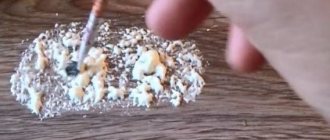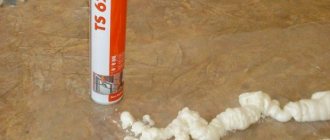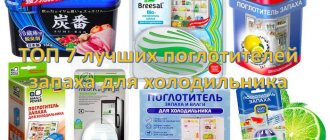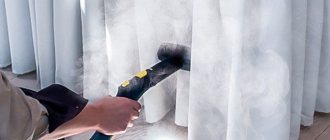Manufacturers of building materials offer various cleaning products for reusable tools. These include flushing the spray foam gun. Let's consider three ways to remove the working mass from the internal and external walls of devices, depending on the degree of hardening of the foam. Let's take a look at a short list of rules for using cleaning products. After reading the article, it will be easier to choose the optimal flush for the gun and complete the task without the help of professionals.
Gun for polyurethane foam Source prom.st
Design and variety of pistols
Polyurethane foam is sold in a liquid state under pressure in sealed containers. Release is carried out using disposable plastic nozzles (household version) or a separately purchased gun (professional or semi-professional type). In both cases, the device of the foam gun is represented by a tube and a trigger mechanism.
Design features
Although the principle of operation of the nozzles is similar, they are noticeably different in structure, composition and functionality. Thus, structurally, separately purchased tools are divided into 2 types:
- One-piece.
These are plastic samples with a metal rod for distributing the working mass. Such models are classified as semi-professional pistols for performing tasks within 1-2 days.
They are relatively inexpensive, but difficult to clean and cannot be repaired. The main reason is the integrity of the structure and high adhesion of polyurethane foam to polymer materials. That's why professionals consider them disposable.
Disposable gun type Source prom.st
- Collapsible.
Here, practicality is explained by the possibility of free access to individual components of the tool. In case of clogging or sticking of the foam to the inner walls of the structural elements, you can remove dry residues and clean the tubes.
This is a professional type of pistols that consists of two prefabricated parts. Here it is possible to replace individual elements and repair the instrument as a whole.
The table provides a brief overview of the individual components of the pistol.
| Component | Functional significance |
| Trunk | The task of this structural element is to supply and adjust the direction of dispensing polyurethane foam to a specific work area. |
| Trigger | Transfer of action to the built-in mechanism in the cylinder. When the trigger is pressed, the working mass is released from the cylinder into the barrel. |
| Pistol (grip) | The most convenient (ergonomic) part of the tool that fits in the palm of your hand. The more comfortable it is for the user, the better the control of the tool and the foaming of the object as a whole will be. |
| Adapter | If we draw an analogy with a weapon, then this structural element acts as a clip for cartridges. Here the device is charged for subsequent release of polyurethane foam to the work area. |
In addition to the basic components, there is a fixing screw. It acts as a regulatory mechanism regarding the supply of polyurethane foam.
Gun with adjusting screw Source karkas32.ru
That is, the mass feed rate and its volume are adjusted. There is a tip on the barrel - a fitting. The only distinguishing feature can be the diameter of the passing hole.
See also: Catalog of companies that specialize in finishing materials and related work
Operating principle
It is worth noting in advance that before releasing the polyurethane foam, it is necessary to perform 2 steps. It doesn’t matter whether this is a household option or whether this or that gun is used. Initially, it is necessary to place the cylinder in a room with a positive temperature for at least 6 hours. The second step is to thoroughly shake the liquid mass. Shaking is carried out approximately 15-30 times in the up and down direction.
Next you need to do the following:
- fix the tool using threaded connections until there is tight contact (the signal here will be a characteristic hissing sound - the release of air or foam);
- press the trigger in a smooth motion;
- point the barrel at the working base.
The gun and cylinder are ready for use Source master-plus.com.ua
When the trigger is pressed, the process of foaming the polymer liquid and the primary stage of its expansion occurs. Due to the pressure set in the cylinder, the foam is released through the fitting under acceleration. On the surface, the working mass increases in volume again by 60-90%. The efficiency of the tool is adjusted by the degree of pressure on the trigger and the adjusting screw.
Basic rules of care
The following rules are distinguished:
- Do not try to remove caulk from the gun with water. The porous structure of the composition will absorb liquid and increase the degree of adhesion.
- When flushing, keep the gun away from you.
- Use personal protective equipment.
- If you plan to use a sealant of a different brand, you first need to squeeze out all the remnants of the previous composition and rinse the mechanism.
- Use a wash from the same manufacturer as the foam.
- Flushes contain flammable substances, so they can be used away from heat sources.
- If you are going to use the gun for the next two weeks, it is better to store it with the cylinder installed and the pressure regulator screwed on.
- Purchase solvent in advance so as not to delay cleaning.
- If, after assembling the equipment, the components leak part of the composition, it’s okay. As you use the tool, these gaps will be filled with foam and sealed.
- Do not use a drill to make a hole in the barrel of the device, as this may cause mechanical damage.
- In a tightly closed container, foam remover can be stored for up to a year.
Tool cleaning methods
It is recommended to solve the question of how to rinse a spray foam gun before the remaining mass hardens inside the structural elements. All specialized cleaners (in the form of an aerosol liquid) are designed to destroy polyurethane foam in a liquid state. The compositions are sold in cylinders with adapters for a gun. The working mass is released until it ceases to be homogeneous and clean. If necessary (usually jamming), the procedure is repeated.
Blowing the gun with cleaner Source ozone.ru
How to disassemble the device
The first thing to do is unscrew the cylinder from the gun. The outlet of the screw should be kept as far away from you as possible so that any remaining foam does not get into your face. Next, the remaining sealant should be removed mechanically.
A screwdriver or a metal rod is suitable for these purposes. After this, the tool is disassembled in the following sequence:
- First, unscrew the mechanism that is responsible for supplying the mixture from the cylinder. It is unscrewed using an adjustable wrench or pliers.
- Next, the trigger mechanism is disconnected and the pin is pulled out with pliers using a rotating motion.
- If necessary, unscrew all bolts and nuts and the foam supply tube.
- Only the skeleton of the pistol should remain.
Video description
What to do if the flushing for the spray foam gun has ended and you need to blow out the gun:
What to do with frozen foam
Often a novice master misses time and the working mass has time to harden. Let's consider the option of how to clean a gun from polyurethane foam if it has dried. Here you first need to cut off the foam residue from the base of the trunk. Then it is lowered down with the tip, and solvent is supplied to the upper part. The chemical reaction will take several minutes. Next, the effectiveness of the procedure is checked using the trigger.
Cleaning the adapter Source prorab.help
If the trigger does not move again, the valve is jammed. Here, the solution to the problem is to treat the area with the ball with a solvent. It is located next to the adapter where the gun and cylinder are connected. The cleaning process for the trigger usually takes about 20 minutes. In rare cases, additional mechanical cleaning may be required.
What to do with a pistol after a long break
If a professional tool was purchased, but was not promptly cleaned after use, it can be put back into use. Let's look at how to clean a spray foam gun if it's dry. Here, first you need to disassemble the structure. It is important not to damage the threaded connections.
The manufacturer indicates how to disassemble a foam gun on the packaging or in the passport Source ad-cd.net
Cleaning the Main Valve
It is performed without dismantling the entire mechanism. If the foam has set and blocked the lever:
- Don't push it too hard. This can damage the base frame;
- Cut the sealant from the tip of the barrel with a blade, try to make a recess;
- Drop remover inside;
- Lower the gun with the barrel down and drop solvent into the stem so that the liquid flows towards the barrel;
- Wait 20–30 minutes;
- Using progressive movements, press the hook until it is released and begins to move freely;
- After washing the lever, try screwing on a tube of cleaner and blowing through the mechanism.
If the trigger is still blocked, a complete flush of all parts is required.
Briefly about cleaners
To remove frozen mass in guns, manufacturers produce products in the form of aerosols. As a rule, cylinders hold 0.5 liters. liquids. The basic component here is dimethyl ketone. It is effective not only in cleaning tools, but also removes foam residues from hands, clothes and other surfaces well.
When working with the cleaner, it is important to follow a number of rules:
- stay away from fire, heating radiators and sunlight (limit heating to +50 degrees Celsius);
- do not allow liquid to come into contact with mucous membranes and skin;
- ensure good ventilation of the room.
If you use cleaners for fresh polyurethane foam, they do an excellent job of treating valves on cylinders, adapters on guns, and internal cavities on individual elements of devices.
Additionally, many manufacturers produce special napkins. They are impregnated with a product that can remove small remnants of fresh foam. Their purpose is to process the outer part of the tool.
If there is no industrial washing
If for some reason you don’t have a special remover at hand, you can use improvised means: gasoline, kerosene, acetone, turpentine or other substances with similar properties.
It should be remembered that even very hot water is not able to dissolve particles of polyurethane foam, and it is impossible to wash the gun with its help.
To clean the tool used to supply the building mixture with a solvent, you need to do the following:
- carefully remove the can;
- using a cotton napkin, remove clumps of foam that have not yet hardened - treat the adapter, the attachment point, the tip of the barrel, the area around the trigger mechanism;
- pour the dissolving liquid into the hole located at the point where the cylinder is attached.
Foam solvent is a substance with high chemical activity. It will quickly dissolve the foam stuck in the gun channel and flow out through the outlet hole. The effectiveness of this method depends on how soon the cleaning was started - the more the composition hardens, the more difficult it will be to dissolve it.
If the mounting agent has already “set”, you should try pouring solvent into the bore from the tip side. To do this, you need to take a medical syringe, draw a solvent into it and inject it into the instrument channel, piercing the hardened foam along the entire length of the needle. You must act as quickly as possible, otherwise the solvent will corrode the soft material from which the syringe is made.
The antiseptic "Dimexide", which can be purchased at any pharmacy for little money, will successfully replace any solvent. In addition to its destructive effect on foam, the product is safe for skin and fabrics. You can not only clean the gun with it, but also wash your hands from foam and glue, and also wipe off soiled clothes.
Certificate of conformity
The production of these drugs is carried out according to the rules of GOST, which prescribes their safe properties, and whether it is possible to use them without respiratory protection, by wearing a respirator.
In addition, the degree of flammability and explosiveness during prolonged heating is prescribed. For these reasons, when purchasing, you must request a certificate of conformity from the seller. This sign must be registered - ROSS VE.AD83.H04410. If the product has a similar designation, then the composition has passed the necessary tests, after which it was assessed positively for its intended use.
The production of these drugs is carried out according to GOST rules.











